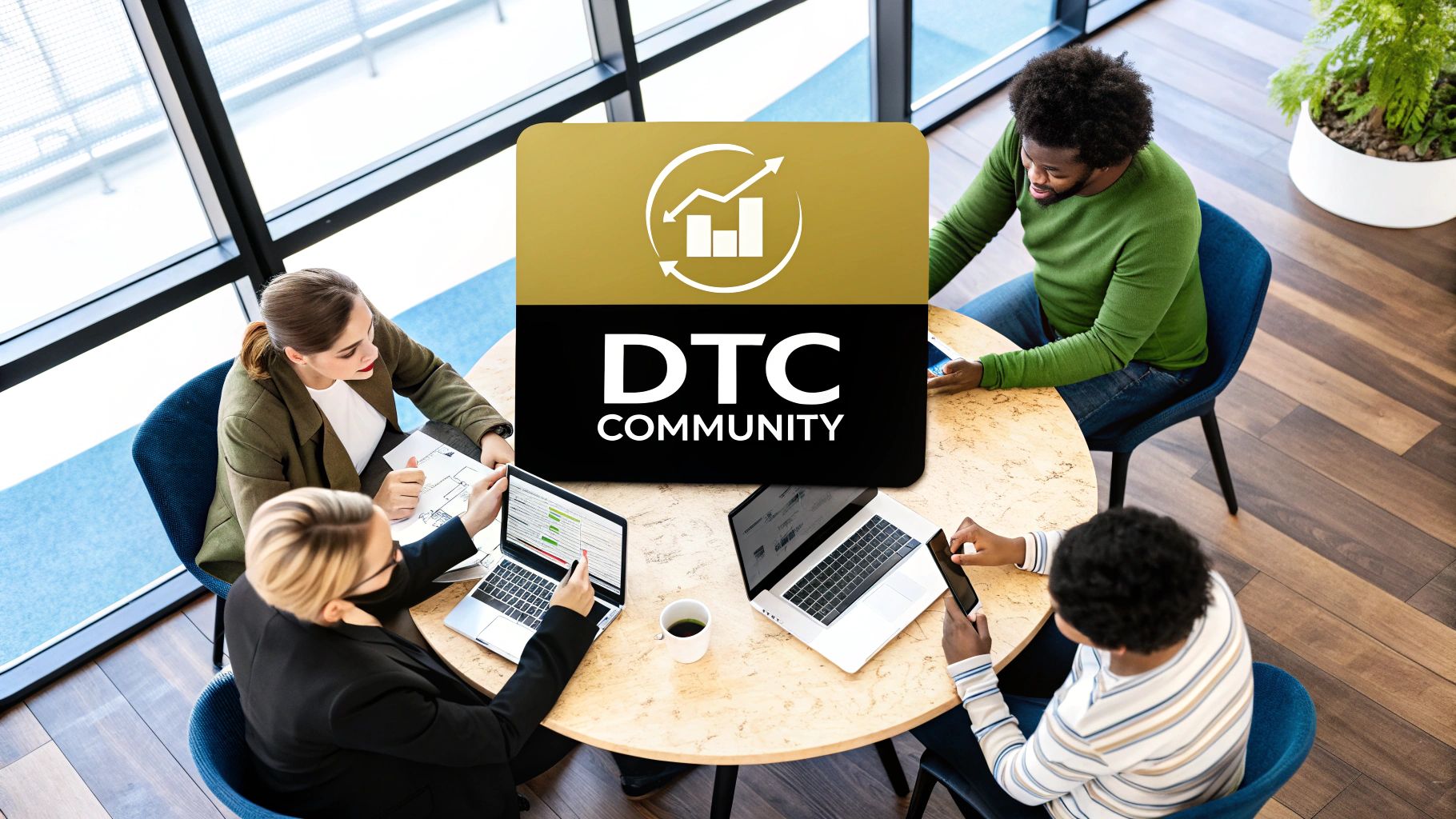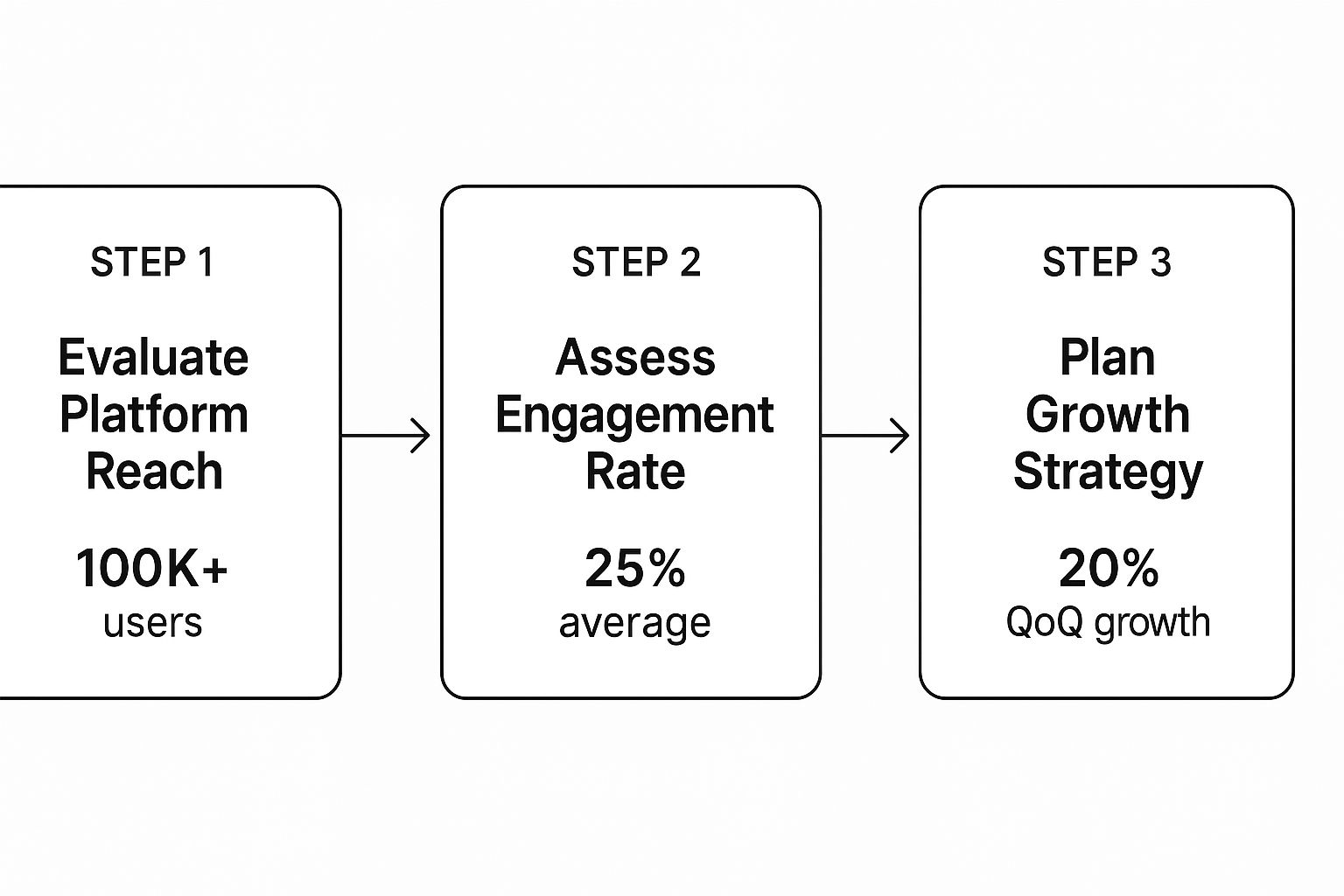Stay Updated with Everything about MDS
Thank you! Your submission has been received!
Oops! Something went wrong while submitting the form.

Chilat Doina
July 31, 2025
Let's be honest, the word "community" gets thrown around a lot in e-commerce. It's often just a fancy term for a big email list or a bunch of social media followers. But a real DTC community is a completely different beast. It's not just an audience you talk at—it's an ecosystem you build with your most dedicated customers.
A true community is all about shared identity and two-way conversations. It’s where your brand and your customers connect on a deeper level, creating genuine relationships that go way beyond the "buy now" button.

Forget the buzzwords for a second. Simply having a lot of followers or subscribers doesn't mean you have a community. Those are broadcast channels—you talk, they (hopefully) listen. It's a one-way street. That's a huge misunderstanding of what makes a DTC community so powerful.
Think of it this way: a passive audience is like putting up a billboard on the highway. You're shouting a message at thousands of people driving by, but you're not building any real connection. There's no back-and-forth.
A real community, on the other hand, is like a neighborhood block party. Everyone shows up because they have something in common—they live on the same street. They mingle, share stories, and build actual bonds. The block party is where the real magic happens.
That's what a genuine DTC community is. It's the block party for your brand. It’s a space where customers don't just buy your products; they engage with you and, even more importantly, with each other. This is the critical difference.
The heart of any great DTC community is a powerful sense of belonging. Your brand might be the host of the party, but your members are the lifeblood. They’re brought together by a shared passion, a common set of values, or a goal that your product helps them achieve.
Take a fitness apparel brand, for instance. Their community isn't just about selling more leggings. It's built around a shared dedication to health and wellness. Members swap workout routines, cheer on each other's progress, and offer motivation, all within the world your brand created. The apparel becomes the uniform for their shared mission.
A genuine community transforms customers from passive consumers into active co-creators of the brand's culture and story. It's a strategic shift from transactional relationships to relational equity.
Making this happen isn't an accident. It takes a deliberate effort to carve out spaces for these two-way conversations. You have to move beyond just promotional posts and start creating opportunities for members to truly connect. The end game? A self-sustaining ecosystem where the value comes just as much from the member-to-member connections as it does from the brand itself. You can find out more about what makes a great ecommerce community in our detailed guide.
To really nail down the difference, let's compare the two side-by-side. Seeing the contrast makes it crystal clear what you should be aiming for.
As you can see, one is an active, living ecosystem, while the other is a static list. The goal is to build the former, not just grow the latter.
So, how do you know if you've got a real community or just a big audience? A thriving DTC community has a few tell-tale signs that set it apart from a simple customer list.
Here are the defining traits to look for:

When you invest in a DTC community, you’re not just chasing a quick spike in sales. You're building a strategic asset that delivers compounding returns over the long haul. While transactions are great, the real magic happens when you foster a genuine connection that fundamentally improves your most important business metrics.
This all starts with Customer Lifetime Value (CLV). When customers feel like they belong to something more than just a mailing list, they stick around. They’ll make repeat purchases not because you sent them another discount code, but because they have a real sense of loyalty to the brand and the other people in the community.
At the same time, a strong community naturally pushes down your Customer Acquisition Cost (CAC). Why? Because your most engaged members become your best, most authentic marketing channel. They tell their friends, post about your products online, and create the kind of powerful social proof that no paid ad campaign can ever hope to replicate.
The endgame here is to transform everyday buyers into passionate brand advocates. These are the people who will jump into a comment section to defend your brand, create detailed unboxing videos, and rave about their experiences without you ever asking. That kind of organic, word-of-mouth marketing is priceless.
Think of it as building a volunteer army of marketers. Their enthusiasm is not only contagious but, more importantly, it's trustworthy. A potential customer will almost always believe a glowing review from a real person over a polished ad from the brand itself. This kicks off a powerful cycle:
A DTC community acts as a competitive moat. It creates a powerful bond that price drops and competitor ads can't easily break, protecting your brand from market volatility.
This depth of loyalty is especially critical in fast-growing industries. Take the consumer healthcare market, for example, which is projected to hit USD 1.81 trillion largely because of a massive shift toward direct brand engagement. In a space that competitive, community isn't a "nice-to-have"—it's a distinct advantage that goes way beyond product features. You can explore more on how brands are connecting directly with health-conscious consumers.
It’s one thing to understand these benefits, but how do you actually measure them? The true value of your community shows up in both hard data and softer, but equally important, metrics. For a deeper look at how to put a dollar figure on assets like brand loyalty, check out our guide on how to value a brand.
Ultimately, it all comes down to building a more sustainable, resilient business. A DTC community gives you a direct line to your most important asset: your customers. They provide real-time feedback, spark new ideas, and champion your brand to the world. That’s the true, long-term power of community.
Let's be honest: a thriving DTC community doesn't just sprout up overnight. If you throw a bunch of customers into a Facebook group and hope for the best, you'll end up with a digital ghost town. Building something that lasts takes a strategic approach, built on a rock-solid foundation.
Think of it like building a house. You wouldn't start putting up walls without first pouring the concrete and framing the structure. These pillars are that essential groundwork—the non-negotiables that will help you turn a simple idea into a vibrant, self-sustaining ecosystem.
The very first step—before you even think about platforms or content—is to lock down your community’s core purpose. Its "why." You have to clearly articulate the shared mission that will pull your members together. This has to go deeper than just loving your product. Are you bringing together people passionate about sustainable living? Is it a group dedicated to mastering a new skill? Or is it a shared identity tied to a specific lifestyle?
This central idea becomes your north star. It guides every single decision you make, from the conversations you spark to the type of people you want to attract. A strong purpose is what separates a genuine community from just another customer support forum.
What’s in it for them? People are busy, and their attention is pulled in a million different directions. You need to give them a compelling reason to invest their time with you, and that value proposition needs to be crystal clear.
This value can show up in a few different ways:
As you map this out, it's worth checking out resources like a comprehensive guide to building online communities for a wider perspective on everything from launch to engagement. It can really help you nail down what makes a space one that people actually want to be a part of.
The best DTC communities are built on a foundation of generosity. You have to provide immense value upfront, long before you ever ask for anything in return. That's how you build trust and set a positive vibe from day one.
So, where will your community actually live? This is a huge decision because the platform you choose shapes the entire member experience.
A Facebook Group is easy to set up and meets people where they already are, but you give up a ton of control and branding potential. On the other hand, dedicated platforms like Circle or Mighty Networks give you full ownership of your data and a more premium, focused environment.
The infographic below offers a simple framework for thinking through your platform choice and setting some early growth targets.

This process really drives home the point that it's not just about getting people in the door. You need to make sure they're actively participating, because that's the only way to build something that will last.
A brand new community can feel like an empty room at a party. It's your job to be the host and get the conversation flowing. Don't just sit back and wait for members to post—be proactive. Ask interesting, open-ended questions. Run fun polls. Personally welcome new members and introduce them to the group.
But your most important job? Identify and empower your most engaged members. These are your future leaders, your super-users. Give them a special title, ask for their private feedback, and feature their contributions.
When members feel a real sense of ownership, they become the engine that keeps the community alive and growing. That kind of authentic energy is something money just can't buy.

Getting a DTC community off the ground is a bit like planting a garden—the real work starts long after you've scattered the seeds. You have to keep nurturing it, or that initial burst of excitement will fizzle out. The goal is to turn that early momentum into a living, breathing space where conversations and value just keep flowing.
This goes way beyond simple welcome posts. You need a solid content rhythm that gives people a reason to come back. Think exclusive AMAs (Ask Me Anything) with the founders, behind-the-scenes glimpses of product development, or even workshops led by your most experienced customers.
You have to find that sweet spot between brand-led events and the organic, member-driven conversations that pop up on their own. As the community gets bigger, you can't be the one sparking every single chat. Your job slowly shifts from being the main attraction to being the facilitator who empowers everyone else.
To keep the conversation going, you need a good mix of content. Sticking to one format gets old, fast. A better approach is to build a content calendar that weaves in different kinds of interactions to keep things fresh and engaging.
The best communities aren't just places where people show up to consume content; they're platforms for co-creation. When members feel like they're building the community right alongside you, their loyalty goes through the roof.
As your community grows, keeping it a positive and safe space is everything. This means you need active moderation, but you also need to really understand the health of your community. That’s where analytics come in—keep an eye on key metrics like active member rates, how often people are posting, and how quickly they get replies.
This data-driven approach helps you pinpoint your most valuable contributors—those awesome members who consistently add value and start great discussions. Recognizing and rewarding these people is a killer way to encourage more of that positive behavior. It’s a foundational piece of building strong ecommerce customer retention, turning happy customers into your most vocal advocates.
This direct line to your audience is also an incredible feedback loop. You can see this trend everywhere, even in tightly regulated industries. For example, nearly 75% of patients in the U.S. now use online reviews to find doctors, which shows just how much power has shifted to the consumer. Even biopharma companies are now using DTC platforms to connect directly with patients, proving that this kind of community-driven feedback is a game-changer in any market. You can read more about how biopharma is entering the DTC market on DefinitiveHC.com.
Ever tried to have a serious business conversation at a packed concert? That's what it feels like for a seven-figure entrepreneur in a public forum.
Open groups and free-for-all forums are often swamped with beginner questions, recycled advice, and people just trying to sell you something. While that has its place, it's a nightmare when you're looking for high-level, actionable strategies. The real gold—the signal—gets completely lost in the noise.
This is where an exclusive DTC community gives you an almost unfair advantage. By bringing in members who are all playing at the same level, these networks cut through the static right from the start.
When you put proven operators in a room where they can trust each other, the conversation changes. It stops being a public performance and becomes a private brain trust, where people can share hard numbers, proven playbooks, and even the expensive lessons they’ve learned.
In a closed-door setting, the quality of discussion just skyrockets. You don't have to waste time explaining the basics because everyone in the room already gets it. You can dive straight into the deep end of complex problems with people who have navigated the exact same waters.
This isn't some niche idea; it’s a reflection of a bigger trend. Just look at the consumer healthcare market, which is seeing steady global growth of around 7-9% CAGR. A huge part of that comes from companies connecting directly with specific, high-value customer groups. Focusing on the right audience is a powerful strategy, and you can see how this DTC approach is shaking up global markets.
At the end of the day, these exclusive networks deliver three core advantages that you just can't get anywhere else:
Of course. Here is the rewritten section, crafted to sound like an experienced human expert.
Jumping into the world of DTC communities is a big strategic move, so it's only natural to have a few questions before you take the plunge. Getting clear on the fundamentals from day one is the best way to sidestep common mistakes and build something that truly lasts.
Let's tackle some of the most common questions we hear from founders.
Before you even think about a platform or send your first invite, you need to nail down your community's "why." This is the shared purpose, the common ground that will pull everyone together. It’s the absolute foundation of everything you'll build.
Is it a shared love for a hobby that connects to your product, like sustainable living for an eco-friendly brand? Or maybe it’s a collective goal, like crushing fitness milestones for a wellness company. Whatever it is, this core mission will dictate your content, your engagement, and ultimately, the kind of people you attract.
Measuring the return on a community isn't just about tracking sales. To get the real story, you need to blend hard data with the softer, qualitative wins.
Here’s what to keep an eye on:
So many brands get hung up on trying to tie every sale directly back to the community. That’s a mistake. The real ROI is in the long game—it's the fierce brand loyalty and lower marketing costs that create compounding value over time.
This really boils down to your goals and what you can handle right now. Kicking things off with a Facebook Group is tempting because it's easy and your customers are already there. The trade-off? You're building on rented land. You don't own the data, and you're always one algorithm change away from disaster.
A dedicated platform like Circle or Mighty Networks puts you in the driver's seat. You control the branding, the user experience, and—most importantly—the customer data. This usually leads to a more focused, committed group of members. A smart play is to start where you can get traction quickly but have a long-term vision to migrate to a platform you own as your community grows up.
For founders ready to skip the trial-and-error and connect directly with proven e-commerce leaders, Million Dollar Sellers is the shortcut. Our invite-only network is where the top entrepreneurs share the strategies that are actually working right now.
Apply to join the conversation at https://milliondollarsellers.com.
Join the Ecom Entrepreneur Community for Vetted 7-9 Figure Ecommerce Founders
Learn MoreYou may also like:
Learn more about our special events!
Check Events